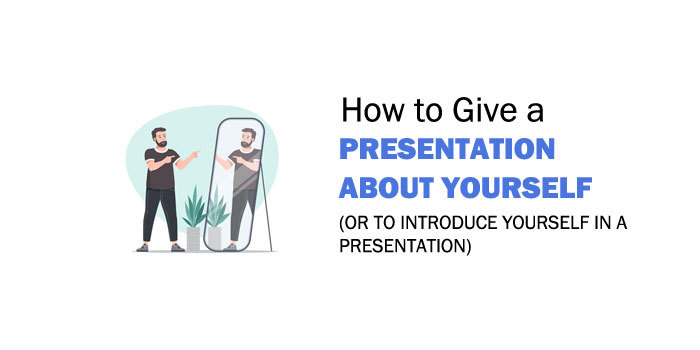How to Introduce Yourself in a Presentation with 6 Terrific Tips
Presentations can be very nerve-racking experiences!
Even seasoned speakers will get the jitters!
When you’re preparing to give a talk about something, you put a lot of time and energy into crafting what you have to say. Understandably, you want things to go as well as possible.
Maybe you’re going to give a speech about an area of expertise that you have in a particular industry.
Perhaps your presentation will to focus on a personal experience that’s had a significant influence on your life.
Then again, you could be getting ready to give a funny speech that you hope will really entertain listeners.
Whatever your presentation is about, your main goal is for those attending your talk to pay attention. Without that, all your blood, sweat and tears − as the saying goes − is for nought!
Giving a Presentation About Yourself
When you introduce yourself at the start of a presentation, it’s the first opportunity that audience members have to meet you formally. So, you should give them the best impression that you can.
It’s critical, at this point, to establish a strong connection with participants that will encourage them to hear you out.
Audiences are known to judge a speaker quite quickly!
The moment you open your mouth, they’re deciding whether they’re going to like what you have to say or if there’s something else they’re rather spend their evening doing.
If it’s the latter, they’ll look for a chance to make a speedy exit as unobtrusively as possible – like when the lights dim so that you can show your first slide, for example.
Here’s how to woo watchers and keep them in their seats with an effective personal introduction.
Start with the Basics
At a minimum, you must tell those listening who you are and what your presentation is about.
If they’ve signed up for the talk, they should know this already. Nevertheless, you need to show them respect by starting off with these few facts.
You never know, someone could be in the wrong meeting room!

In addition, this is the time to pique participants’ interest by briefly saying why it is that you’re giving this particular speech.
Typically, you’ll do this by offering your credentials or a little of your experience on the subject matter.
Here, you can also include a comment about what you hope listeners will learn from you.
You may have heard this approach referred to as the elevator speech or elevator pitch.
In this instance, it’s all about giving people the basic information they need in preparation to hear your speech, and doing it concisely in simple language that everyone will understand.
Here’s a sample:
‘Hello. My name is ___________. I’m a neuroscientist. I’m here to talk about how the body responds to stress and what we can do to improve our stress responses.”
Construct the Connection
Beyond offering the basics, give some thought to how you’d like audience participants to remember you.
This where you must consider how to make the right connection with listeners.
Sure, you want them to think favourably of you but what are the particulars of that good impression?
Can you imagine what they might tell others about your talk?
Do you want them to go away and Google more information about your speech topic?
Are you interested in having them follow your story on social media?
This will determine what you tell them in addition to your name, rank and serial number, so to speak, and your subject matter expertise.
Here are a few steps that will help:
1. Predict participant profile
For any presentation, you should know who you’re speaking to.
While you can’t be expected to know anything about audience members as individuals, you should be able to get a general sense of them in terms of their demographic and other characteristics.
Say you’re speaking to members of a local club. Find out ahead of time why these folks are members of the same organization.
Are most of them retired and looking for a social outlet? Is the club focused on providing a service to the immediate community, or doing good works oversees?
Try to develop a loose idea in your mind of what the participants have in common.
2. Think like listeners
As much as possible, try to put yourself in the shoes of the people coming to hear your presentation.
Be very careful not to generalize or assume too much based on what you understand connects them as a group.
Just use what you know as a helpful yard stick to gauge what you can say about yourself that might resonate with them – or with the majority.

Maybe you’re giving a talk about how to achieve financial success, and your audience is all 20 somethings struggling to pay off student debt while juggling a few jobs in the gig economy.
Certainly, you should introduce yourself with regard to your financial expertise. However, you’ll make a stronger impact on them if you can relate to being a starving student once yourself.
They need to get that you know what you’re talking in both respects and what you’re going to tell them will be valuable.
3. Use universal understanding
Regardless of the diversity in your audience and how they may differ from you, there are some day-to-day life events that most of us can connect with.
Use this common appreciation to create empathy in your self introduction.
You might be able to bond early on with participants by mentioning interpersonal relationships, traffic jams, work challenges or inclement weather, for instance.
When you can offer something else about yourself in this way, it will enhance the connection between you and your listeners.
Succinctly explaining your back story, or your personal perspective, as it relates to your topic will grow your credibility.
Here’s a sample:
“Hello. My name is ____________. I’m a family therapist. When I was a child, I had a sibling that suffered from mental health problems and that’s why I became a therapist. I’m here today to tell you how we can strengthen and heal relationships with others.”
Putting it All Together
There are a few terms you may hear that sum up putting these pieces together to introduce yourself.
It’s called the Rhetorical Triangle or the Triangle of Trust. Simply put, it’s about connecting yourself to the message and then connecting your message with the audience.
It may be easier to remember if you can visualize a triangle with three points – speaker, message, audience.

This demonstrates the importance of speaking from one’s knowledge base, presenting the message logically and appealing to the audience’s emotion.
It reinforces that people are more likely to listen to and connect with you when you appear to know what you’re talking about and have a passion for the subject matter.
You might also like: Preparation: How to write a Speech Outline (with Examples)
6 Ways to Work your Introduction Magic
Once you’ve got a good idea of what you want to say about yourself in your presentation, it’s time to fine tune your plan. Here are several tips to make your personal intro really pop!
1. Communicate clearly
It shouldn’t surprise to you that you need to speak at a reasonable volume and enunciate your words clearly.
A successful speech starts out strong.
Therefore, when you’re telling listeners who you are and a bit about you this is the place to practice communicating properly.
You may feel reluctant to ‘toot your own horn’ but the audience needs to know a little about you and also how to say your name correctly.
So, speak up!

If your name might be a difficult one for some participants to pronounce, take the time to walk them through. Here are two illustrations:
“Hello. My name is Adeolu Akomah. That’s pronounced “ad – e – o – lu – a – kom – ah”.”
“Hello. My name is Ryan Trench. That’s pronounced the same way as in “trench coat”.”
2. Make it natural
As much as possible, put your nervousness aside and try to be yourself.
In other words, show your personality sincerely and don’t try to present an image of someone that you’re not.
We can be forgiven for watching other presenters and thinking that they’re more compelling speakers or have a special charisma.
This may definitely be the case, but how do you think most of them became this way?
It’s because they learned to be comfortable in their own skin when giving speeches.
We each have a unique personality and one key to connecting with an audience is to show that when introducing yourself.
3. Set the tone
Building on the previous point, set the proper tone for your talk.
Will it be a quite formal presentation about a serious subject?
Or, is it going to be an entertaining personal story where you want participants to feel a little laid-back and not restrain their laughter at the right moments?
Try to match the emotion in your voice to the purpose of your presentation.

There’s nothing wrong with speaking in grave thoughtful tones when you want to pull on people’s heart strings with a serious subject matter like childhood cancer.
By the same token, letting a few chuckles escape when you introduce why you’re an expert on skiing mishaps can also stage an appropriate mood.
Setting the tone also means being polite and showing participants that you appreciate their attendance. Acknowledge them with a short welcome or thank them for coming.
4. Bring best body language
Body language is a critical component of giving any speech.
During your personal introduction, your body language can help to build trust or cast doubt on your words.
Strive to appear relaxed and confident
Listeners will then be more apt to believe that you are who you say you are and that you have something to tell them that’s worthy of their time and attention.
5. Watch for TMI
This is a trickly one!
TMI, or too much information, is generally a judgement call based on the aim of your presentation.
So, how much is too much?
Well, you mustn’t offer your whole life story! Just zero in on the relevant details that are necessary to set the stage for your speech.

We’re all complex individuals with varied and interesting backgrounds and life situations. Your audience gets that but they want to know what’s drawn you to speak to them today.
As already touched upon, how to describe yourself as an expert is critical.
It’s okay to be humble but remember that you need people to understand that you know your subject matter so give them enough to go on.
6. Strategize with stereotypes
‘No two ways about it, your audience is bound to stereotype you when they hear a bit of your background.
There are two methods to use this to your advantage.
First, you can capitalise on the typical stereotype and reinforce it with some self-deprecating humour. Maybe you want to play up being a science geek.
Alternatively, you can turn the stereotype on it’s head by introducing yourself as an atypical example of what listeners may be assuming when they hear your background.
Say you’re a grandmother who is giving a talk about saving the environment. If you’ve sailed solo across an ocean, weave that into your introduction as it relates to your passion for ecology.
Whatever you choose, think of what works best to connect with your audience.
Try Out Toastmasters
Here’s another approach to learning the fine points about introducing yourself in a presentation – learn from Toastmasters International.
If you’re not familiar with this organization, essentially, they’re a club where people meet regularly to study and practice public speaking and leadership skills.
Plan to drop in at a meeting as a visitor when someone is giving a talk, or watch online videos of members presenting.
These are two ways to observe how people apply what they learn through Toastmasters to give a great introduction about themselves.

The other choice is to read up on the first speaking project that all Toastmasters members take on.
This is called the Icebreaker speech. The objective is for presenters to give a short talk about themselves so that other members can get to know them.
Of course, this is definitely a different type of speech!
Having said that, the Icebreaker lesson reinforces that you can choose what exactly you want people to know about you, and its good practice for getting comfortable talking about yourself.
The guidance given is to say something about your life experience, your occupation, what you spend your time doing and/or your family.
People love personal stories so no matter what you choose to tell them about yourself, they’re bound to find it interesting and probably will notice several points of connection they have with you.
What’s more, even if you’re not a member of Toastmasters International, you can access the Icebreaker speech instructions free online.
If you do decide to delve further into Toastmasters, you never know, you might quickly get hooked!
Related: What to Expect at Your First Toastmasters Meeting
Conclusion: Giving about Presentation About Yourself
How you introduce yourself when giving a presentation can make all the difference.
Be mindful that the start of your talk is when you have a captive audience.
And, make sure you use that edge to intrigue them and then make a smooth transition to the content of your speech.
By following a few pointers about the best way to introduce yourself, you’ll leave listeners with an immensely memorable experience!
